Opinion Writing Rubrics & Graphic Organizers CCSS Aligned for Grades 3rd – 5th
7 writing rubrics with student self-assessments (for a 3, 4, 5, & 7 paragraph essay) created for the progressing writer. There are 18 rubrics in all to include the extra credit variation. Excellent for mixed or leveled classes to give students individualized instruction. Rubrics are created with variation. Practical and easy to understand. Students will know what is expected of them and they will have opportunities to reflect on their work.
Included in this resource:
✓ How I Use This Resource
✓ 12 Outlines/Graphic Organizers
✓ 2 Posters
✓ 1 Key Word List
3, 4, 5, & 7 Paragraph:
✓ Basic Rubric 1 – Without Extra Credit
✓ Basic Rubric 2 – With Extra Credit
✓ Basic Rubric 3 – With Extra Credit & Parent Signature
4, 5, & 7 Paragraph:
✓ Advanced Rubric 4 – Without Extra Credit
✓ Advanced Rubric 5 – With Parent Signature
✓ Terms of Use
✓ Graphics and Fonts Credit
*Teacher rubric on one side while student self-assessment is on the other side when printed.
*Rubrics are created with variation to meet your classroom’s needs.
*Can print rubrics front and back to save on paper (cut it in half.)
*Peer edits for students to share and learn from each other.
*It’s a very detailed checklist.
*For a 3, 4, 5, & 7 paragraph opinion essay.
*Checklists are full & half page PDF format.
*Can print checklists front and back to save on paper.
*Practical and easy to understand rubrics for teachers and students.
*Easy scoring on a 10 or 5 points each category out of 100 points.
*Great for mixed or leveled classes to give students individualized instruction.
*Teacher and student self assessment to grade a 3, 4, 5, & 7 paragraph opinion essay.
*Add CCSS.ELA-LITERACY.W.3-5.6 by having students research the Internet and type up the essay to implement technology for a cross-curricular assignment.
*Add CCSS.ELA-LITERACY.W.3-5.7 & W.3-5.8 by having students conduct a research project by assigning a prompt. Have them gather relevant information through printed or digital sources. Be sure to have them add a bibliography.
*3-5th Grade Common Core Aligned.
*Can be used as enrichment for 2nd grade students.
The way I use this resource…
In writing, I scaffold and model information to my students. Each class is different and each year is different; therefore, I can’t do everything the same each time I teach the same subject. I start with the basic rubric and introduce 1-3 new concepts each essay. Once I introduce a concept, I hold students accountable for the concepts I taught. If it appears that the majority of the class does not understand the concept, I do not hold them accountable and I reteach the concept. I try not to stifle their creativity by focusing on spelling, capitalization, and punctuation during the first two terms of school depending on the class. I also can easily use the 6 traits of writing with the rubrics. Make sure you choose a topic that is relevant, relatable, and the reasons are researchable.
When filling out the rubric, simply circle the number(s) the student(s) earned. The outline and graphic organizers are an optional teaching tool to help the students organize their thoughts. Depending on the class, I may start the school year off by requiring a 3 paragraph essay then work our way up to a 7 paragraph essay.
Next, I introduce the peer editing checklist. I have students pair up and exchange papers. I have clipboards students can use while they sit around the room for this activity. It’s important for you to model for the students how to peer edit. Many times students just want to be nice and not give feedback. However, this is a great opportunity for students to read each others essays and learn from each other. I try not to let the same students peer edit with each other every time in order for students to view a variety of styles over the school year.
Additionally, there is a student self-assessment included. This is a good tool to help students understand how they are being graded and reflect on his or her own writing. The self-assessment should be completed after the peer editing checklist if it was purchased.
When the class is ready (score 80% or higher), I introduce the advanced rubric to step it up a notch. The thesis statement is used in the advanced rubric. If needed, students can still use the basic rubric for their level for individualized instruction.
Furthermore, there are 18 rubrics in all (basic and advanced) for 3, 4, 5, and 7 paragraph essays. You can choose with or without extra credit. The way I use the parent signature for extra credit is that the parent can sign anywhere on the paper or rubric. I let parents and students know to look over their child’s paper and write directly on the final copy to fix any errors. There is only one rubric in basic and advanced that has the parent signature because it may not work for your classroom.
Finally, you are able to print front and back! Then you can cut them in half to save on paper. For example, pages 12 and 13 are the same rubric. Simply print it from your computer or printer as two-sided. If this does not work for you, print the first rubric for a full page rubric.
Happy Teaching!
Sally
